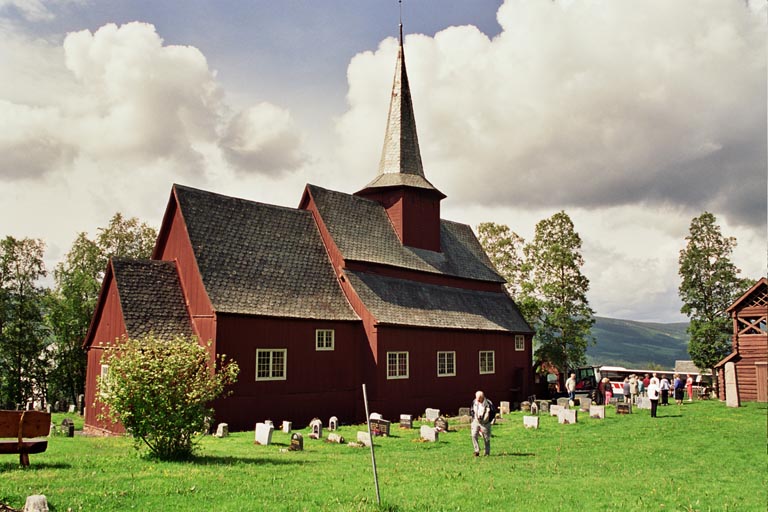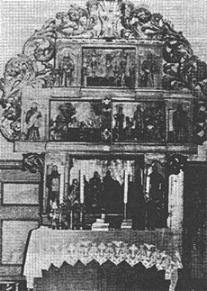Adventures of Judas Statue…
Tale Hangs on Altarpiece of Hegge Stave Church
Judas Iscariot is fallen! That is not news. It was recorded in the Bible two thousand years ago. But not everyone knows that he fell again on a trip from Gudbrandsdal to Valdres – and thereby hangs a tale of how Hegge Church in East Slidre received its beautiful altar. .
.

At Easter time in 1782 four men from East Slidre were on their way to Gudbrandsdal. They were farmers from the Hegge area, but they also dealt in livestock. Thus each spring, while there still was good skiing, they would make their way to Gudbrandsdal to purchase cattle. Later, when the grass had grown enough to graze, they would herd their purchased livestock to Valdres.
On this particular trip, to purchase cattle, they were overtaken by a terrific blizzard, far from habitation. They dug themselves into the snow in an attempt to survive. They had little food and less fuel and were in desperate straits. Fearing for their lives they vowed that if they got through alive each would give a cow to Hegge church. As they took their vow their smoldering fire became a warming blaze, and after nearly two days the blizzard abated.

The first thing they viewed in the distance, when the storm was over, was Heidalsmuen, their intended destination. But they were so weakened by their experience that they felt it wisest to go only to Skabu, which was closer. Providence must have guided them for, arriving at Skabu, they came to the home of a wood carver, Eystein Kiorren (Osten Kjorn). Eystein was then carving an altar piece for the Kvikne church. The Valdres were so impressed by the half-completed carving that they immediately purchased it. The price has been given as one hundred dollars, though another source says sixty. At any rate the cost was greater than the value of the cows they had promised but they purchased it anyway. The piece was not completed however, and would have to be transported to Hegge later.
The next winter the men again skied to Gudbrandsdal, this time pulling a ski-sled along. The altar was now completed so they loaded it on their sled and headed back towards Hegge. The return trip was uneventful, or so they thought. But when they unpacked their treasure they discovered a carved figure from the altar piece was missing. It was that of the traitor Judas Iscariot. He had fallen again this time somewhere in a snowdrift between Gudbrandsdal and Valdres. It seemed an impossible task to discover Judas but when the snow melted he was found in a clump of birch along the trail. Although somewhat paler for his experience he still clutched his money bag containing 40 pieces of silver. Folk proposed he should receive new paint but the pastor protested that Judas got no more than he deserved so his color remains.
Though this altar piece dates only back to 1782 (some say 1780), Hegge church is much older. It is first mentioned in preserved documents from 1327 but probably dates back to the early 1200’s, and according to the church historian Anders Bugge, the church originally stood at Nedre Volden on a site where burials have been discovered.
The church was a typical Valdres basilica type stave church. In many ways the construction is so similar to the stave churches at Hurum (Hore) and Lomen that an authority, Roar Hauglid states, “They are sufficiently similar for us to assume that they were built more or less at the same time and may even have been the work of the same master-builder.
Like other stave churches in Valdres, the Hegge church was richly adorned with carvings. Those on the church portals probably date from ca. 1200 or the first half of the 13th century, according to Bugge. The half-round pillars at each side of the door opening are adorned with entwined dragons and vines. These are crowned by a four-legged animal with a long neck and a twisted tail – apparently a lion. The chancel planks, now in the Olsaksamling in Oslo, are decorated with elegant spiral vines.
Grotesque carved faces surmount the supporting columns within the church. In some early churches these faces are in quiet repose but those in Hegge church and in some others are ugly caricatures, perhaps with a wry mouth, tongue sticking out or with other exaggerated features. One of these is believed to represent the heathen god Odin.
It has been necessary to do major work on the church from time to time. In 1706 Ulfve Johansen Vaarum was employed on the church. In 1712 Gulbrand Maelby lid some repair work as the old door pillars were quite rotted. Bugge also mentions the possibility that carved dragon heads were made for the church in 1694. After the Reformation ridge turrets were raised, which changed the external appearances, according to Bugge. The stopul (bell tower) in which the bell hangs is similar to that at the Slidre church in that the lower story of the tower is wider than the upper one. It is built apart from the church.
The pulpit at Hegge is many-sided with bowed sides and apparently dates from the first half of the 1600’s. In the old days it was believed the baptismal font should be of stone, which is true of the one at Hegge. Its basin is externally decorated with ornaments of knots, trees, human figures, and stars and has the imprint ‘Mitchell, London.” Other artifacts in the church are a chalice given by sogneprest Bugge in 1685. This was made in Kristiania (Oslo) and is stamped “R.H.” A vestment at the church, made of coarse linen dates from 1686, and a painting of “Isaac’s Sacrifice” was presented to the church by Erick Genalson in 1643. But it is the altar piece which is most outstanding.
The wide frame surrounding the upper part of the altar piece is made up of luxurious, deeply carved acanthus vines. Within this and below it are carved figures, singly and in groups.
Judas is not the only altar figure to disappear from the Hegge altar. Several years ago four of the altar carvings were stolen since the church was left open for visitors to enter. On one occasion, as the custodian entered, a stranger hurried out, entered a foreign car and sped away. Later the custodian became aware that four carvings were missing. They were never discovered or returned so the Valdres carver Oystein Rudi was delegated to carve replacement figures. Working from photographs of the originals he was able to duplicate them so closely that only through a minute examination could authorities from Riksantikvaren determine which were the new carvings.
The old church was constructed without the use of a single nail. The timbers were great, some planks measuring two feet in width while the main door which is 82 cm. (33 inches) wide was of one board.
And while it is the carved figures on the altar piece which attract the most attention, there are other statues present but often unseen. Up in the tower are certain carvings. Some believe they are gods of the pre-Christian era. And one has only one eye – perhaps Odin was his model?
Color Photo Courtesy of ‘VALDRES’